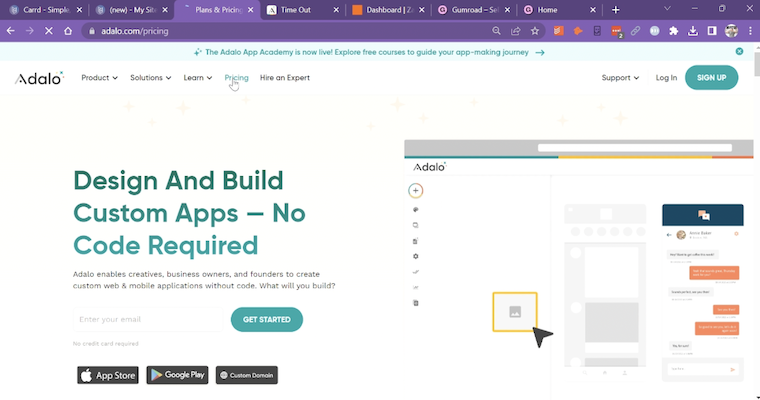No-Code Tools Make Digital Prototyping Easy

Building a product prototype, especially in the technology sphere, used to be expensive and take forever. Heavy upfront investment was a necessity – or at a minimum a lot of free time and well-developed programming skills. In the past 5 years, however, with the advent of “no-code” tools, it’s become exponentially easier for someone without experience, and without a lot of cash on hand, to build a product and business.
Today, I want to give you an introduction into the world of no-code - how it can be used for early-stage entrepreneurs, and general practices on what to do and what to avoid.
What are no-code tools?
First off, let’s dive deeper into what no-code exactly is. Very broadly, a tool can be categorized as “no-code” if it helps you do something, build something, automate something, etc. without your needing to write code or understand a programming language. The tool breaks down programming logic and functionality into simpler building blocks, allowing you to develop your own technology solution (such as a website, a mobile/web app, an automation, a program…) without needing to know how to write code.
A few well-known examples of these no-code tools are:
- Squarespace or Wix | Website builders
- Bubble.io | Web app builder
- Zapier | Automation builder
But there are hundreds of these tools, and each one is good at something different. As a general best practice, if you need to build a certain type of program or product, try googling “no-code” and what you want to build. Chances are, there’s a YouTube tutorial, a template, or a walkthrough guide on how to build the exact digital product you need.
That’s something else important to keep in mind if you’re using no-code: templates. Many of these no-code tools are built with specific products in mind, and they make it super easy for the average customer to get started super quickly by providing templates. For instance, if I wanted to build a platform like AirBnb for a specific niche, tons of platform templates, or marketplace templates, are available on Bubble.io, and almost everything I need besides my own custom branding has already been built for me within that template.
The no-code space is pretty vast, however, and finding the right tool with the right templates to start buliding ASAP can get a little frustrating. A website called Beyta.co lets you search through templates across a series of different tools, which I often use when I’m building a new project. It also gives you information on the right tool to use when you dive into certain templates.
Some beginner tools to choose from
Here’s what you need to keep in mind. In the same way that each tool is good at different things, each tool also has its own learning curve. It’s not nearly as long as learning a new programming language, but it can take up to a couple of weeks for a person to learn to really build something substantial.
Bubble.io, for instance, is an insanely powerful tool, and it’s considered to be at the top of the line in terms of functionality for no-code web apps. However, it’s also one of the hardest tools to learn: expect that you’ll need to take around an hour per day for two weeks or so before you really get the hang of it.
If you’re planning on using no-code as a beginner, or teaching it to others in a classroom setting, here are the “beginner” tools that I most often teach at universities:
- Carrd.co - a super simple, extremely cheap website builder with very little learning curve.
- Adalo.com - a drag-and-drop, intuitive web and mobile app builder.
- Zapier.com - a well-designed no-code automation studio.
- Gumroad.com - an easy and free payment system that lets you sell products easily.
Those tools apply generally for anyone getting started - they’re a great beginner toolbox, and they’re almost entirely what I use when I’m starting with a new idea.
More about Carrd
Let’s dive into those beginner tools a bit more. First off is Carrd, the simple website builder. A lot of early entrepreneurs I talk to get worried when it comes to website builders, and believe it’s something they need to outsource instead of trying themselves - and a lot of that fear comes from older tools they may have used, like Wordpress.
For the longest time, Wordpress was the de-facto system for building almost all websites. While it is powerful, the learning curve is absolutely ridiculous. I personally think the interface is inexcusably non-intuitive, and I hate using it when I’ve had to do so in the past for clients. Carrd, and a lot of other newer no-code website builders, don’t have this issue.
Carrd is drag-and-drop, and what you see is what you get. You’re building on a visual canvas, moving content around with your mouse, and you click publish when you’re done. The site looks exactly like it did as you built it, and it even optimizes for mobile pretty well automatically. No hosting is required; it’s hosted on Carrd’s servers; and the paid plan is absurdly cheap, especially when compared to older tools like Wordpress.
If you need to get an idea up on the web to show customers, you can do it incredibly fast with tools like Carrd. One of my favorite things to do with the tool is test out new ideas rapidly. I build a landing page that pretends my startup idea exists, with a waitlist or “beta” signup form on the page, and then post it to a number of related subreddits and forums online to see how potential customers react. I can accomplish this in about 2 hours if I’m fast - and that’s a pretty insane turnaround time for getting an idea out into the world for customer feedback.
More about Adalo and Zapier
Now on to Adalo, the more complex builder in the list. Adalo is wonderful, and works in a way similar to Carrd in that it’s drag-and-drop simple - but there’s an added layer of app functionality you can program, like backend databases, user logins, and more.
Adalo is best used for actually prototyping your tech idea. It’s got enough functionality to build most concepts quickly, and their free plan lets you assemble a few users for real testing before you need to pay for anything. I most often use Adalo for things like platforms, marketplaces, maps, directories, etc.
Zapier is next - and it’s definitely the most powerful of the bunch. Zapier lets you automate data and interactions between tools. That sounds complicated, but let’s work with an example. Say I have an app I’m building on Adalo that needs to send text reminders to its users. Adalo doesn’t natively have text functionality, but all I need to do is select Adalo as the trigger, and an SMS tool as the action in Zapier. Then I answer a few questions on how I would like the automation to function, and boom. Now whenever a specific action happens on my app in Adalo, a text is sent automatically to my user. I was able to add text functionality using a Zapier automation in minutes.
Zapier is great for connecting different tools in the world of no-code to add functionality to something you’re building. Many no-code builders are built with the use of automation tools like Zapier in mind, so they make it extra easy to add functionality using it.
More about Gumroad
Lastly, we’ll talk a bit more about Gumroad. This app is pretty specialized, but it works really well with Carrd. It’s just a simple payment tool that lets you collect money from your users in the form of one-time payments and subscriptions. You create a simple form, set a price, add some pictures and variations of your product, and now you have a payment page. Add that link or embed the page on a Carrd website, and you have an e-commerce store that’s online completely.
Since a ton of small business ideas are usually online stores selling niche products, Gumroad is a great tool in your arsenal. They’re also free, though they do take 10% of every sale. That’s great in the beginning, and you can easily switch to something that takes less of a percentage down the line, once you’ve tested the concept with your customers and you’re sure it’s worth the time and cash investment.
Conclusion
Initially, no-code tools enabled you to illustrate an idea but weren’t very functional. Increasingly, though, no-code tools can be used to build a working website that can get you through the launch of a business concept. So you can get things up and running while giving you time to decide how much further investment to make, and to find additional resources that can help you take your ideas further. With these four tools, and a little research into other specialized tools you might need to connect over Zapier, you have 90% of what you need to build most digital business ideas.
Overall though, the no-code space has a lot more to offer. For any early entrepreneurs looking to leverage no-code, I’ve compiled a giant resource of tools here as a starting point.
The best thing you can do is start building something as soon as possible. Google how to build the product you have in mind with no-code; watch some tutorials on YouTube; and get your idea out there.
Watch a demo
Max Mirho demonstrates how no-code tools work.



.png)